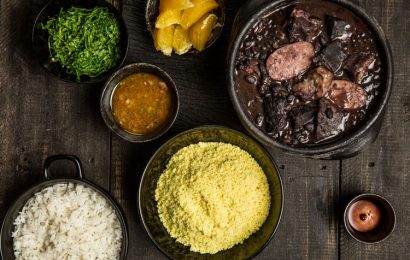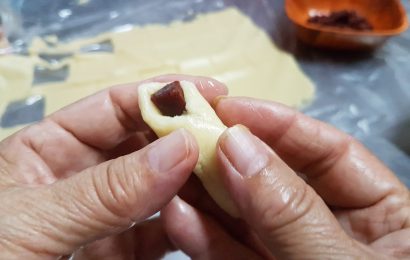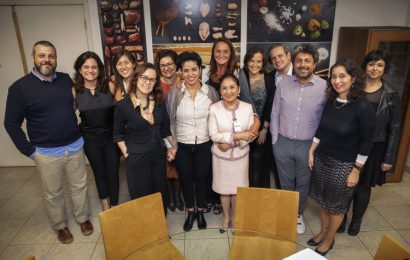“I cook in the name of education”, said Janaína Rueda, chef of Dona Onça restaurant (and also part of the crew from A Casa do Porco, Hot Pork and Sorveteria do Centro, important places of São Paulo food scene).This message has echoed in the voice of about 20 members of Vai-Vai community, a traditional samba school from Bela Vista neighbourhood, in São Paulo, who attended a training in Brazillian cuisine that took place at one of the FMU Gastronomy Course’s kitchen last Tuesday (29th of October). The course is a partnership with Instituto Brasil a Gosto and the university. In a total of four meetings, Janaína taught how to make four recipes that are very representative of our cuisine: feijoada (beans and meat stew), moqueca (fish and seafood stew), galinhada (chicken stew with rice) and stroganoff.
The idea was that after the course the community would feel able to cook these dishes at his headquarters (known as “quadra” in Portuguese) whenever there is an event or the need to raise funds for all the activities organized by the samba school.
“I grew up in this ‘quadra’ and a lot of what I’ve learned, including my values, I’ve learned at Vai-Vai. Nothing can be more gratifying and fair than giving this back by teaching a little bit of what I’ve learned being a cook. Some of these ladies have known me since I was a kid! It is very touching to see this project happening”, said the chef.
Janaína emphasizes that the initiative goes far beyond the knowledge transfer: the group itself starts to spread this knowledge at their own circles, among friends, family or neighbours. “These small gestures make a huge difference. It is common that the information they get here – for instance, that they should replace industrialized seasoning for homemade options – doesn’t get to them via other sources”, said the chef.
In the kitchen
In the first lesson they learned the basics of making feijoada. Janaína taught them her recipe, step by step. She told them that she prefers fresh meat instead of the ones that are cured, which have lots of salt and need to be unsalted. “This used to make more sense when we didn’t have a fridge”, she explained. For seasoning, she uses only salt and black pepper. And to grill, she uses a very hot frying-pan to provoke Maillard reaction – that is responsible to create crust in the pan and improves the taste from meats and veggies. The “fry and drip”, when you add just small drops of water while cooking, also helps to enhance meat preparations preventing it from burning.
After searing, all the meats go to a pressure cooker for no longer than two hours to complete the cooking process. Rice for the troops: saute onions first, then garlic. Fill the pan with water, let it boil and add the rice. Stir it and keep an eye on it. When it starts to dry, turn off the heat and cover the pan with a lid.
Serve it with collard salad, banana tartar, farofa and chili.
Heritage food
For the second meeting, Janaína chosen moqueca. And the star makes the night very juicy – in the pan and in the conversations about it. “When you talk about this dish in Brazil it is always about if it is Baiana (from Bahia) or Capixaba (from Espírito Santo). In this case, the answer is neither! Mine is the Janaína’s one!”, she said. “And I considered in it any influence possible to trace, because it is the result of lots of influences: Portuguese stew, indigenous ‘moquém’ (a technique from Brazilian native communities used to dry or roast food in something that resembles a barbecue place made with wood sticks) and the ‘poxeca’, a fish and seafood from African traditions”, she added.
From theory to practice, Dona Onça (a nickname Janaína is also known by and that gives names to her main restaurant) highlights that the soul of this dish is in making the base, the broth, without wasting anything and that it must have fishbones and fish head cooked with vegetables for, at least, 30 minutes. The classic recipe uses carrot, celery and onion, but she encourages everyone to use what is left in the fridge, including green leaves or even cabbage. Prepare it and set it aside.
Just like she did with the feijoada, she says that the Maillard reaction – to make a golden crust in the pan – is what gives flavour to the recipe without making it heavy, since it uses lots of spices and palm oil. “To start, just stir fry onion and garlic in some oil. Then you will add peppers, that must have been sauteed first (separated, one by one). I used red peppers, green peppers and double the amount of these ones of yellow peppers, which tastes softer. Then you add to it, in a big pan, the broth, let it simmer for some minutes, add slices of tomatoes, turmeric and, if you like it, a drop of palm oil. When it gets thicker, add the fish and the prawns and cook them for only three minutes, so they don’t break apart. Turn off the heat and add fresh parsley and spring onions”. This dish can be served with manioc flour (in flakes or fine grain), rice, chilies, banana puree (made using banana nanica cooked in water with salt and beaten until mashed in the food processor).
Yes, Brazilian
Starring the third meeting was the stroganoff. Janaína told the story of the recipe, that was supposedly created in the kitchen of count Stroganov, in Russia, and is made using sour cream and beef preserved in vodka. It came to Brazil thanks to the rich coffee barons who were enchanted by the dish they had discovered in France. Janaína made a point of teaching a version without ultra processed ingredients like mustard, Ketchup or Worcestershire sauce. “It is the same recipe I taught to school cooks of São Paulo state, cheap and without ultra processed ingredients”, she said. As seasonings, just salt, black pepper and lots of onions. Instead of using preserved mushrooms, she used fresh mushrooms. Another tip from the chef is how to prepare the potatoes: do not wash them so they don’t lose starch. And to make them crunchier, she adds a bit of extra maize starch. In the frying pan, the potatoes and the oil are added at the same time and are heated covered with a lid. She removes the lid only after it starts boiling and she keeps control of the frying process. The results: pass with merit.
The last lesson was held on November 19th and was about galinhada. The recipe, news and other details will be published here soon.



